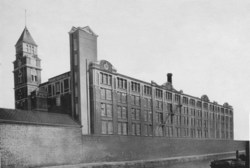Trencherfield Mill

Trencherfield mill, the working mill in 1951
|
|
| Cotton | |
|---|---|
| Spinning (ring mill) | |
| Location | Wigan Pier |
| Serving canal | Leeds and Liverpool Canal |
| Further ownership |
|
| Coordinates | 53°32′28″N 2°38′16″W / 53.5411°N 2.6378°WCoordinates: 53°32′28″N 2°38′16″W / 53.5411°N 2.6378°W |
| Power | |
| Date | 1907 |
| Engine maker | J & E Wood |
| Decommissioned | Still in steam |
| Engine type | triple-expansion four-cylinder engine |
| Valve Gear | Corliss valves |
| rpm | 68 |
| Flywheel diameter | 26ft |
| Transmission type | ropes |
| No. of ropes | 54 |
| References | |
Trencherfield Mill is a cotton spinning mill standing on the Leeds and Liverpool Canal, Wigan, Greater Manchester. It was built in 1907. It was taken over by the Lancashire Cotton Corporation in the 1930s and passed to Courtaulds in 1964. It was driven by a 2,500 hp triple-expansion four-cylinder engine built by J & E Wood of Bolton in 1907. The two halves of the engine were called Rina and Helen. They drove a 26-foot flywheel with 54 ropes at 68 rpm. The engine was stopped in 1968. It is now part of the Wigan Pier redevelopment area. The mill has been redeveloped.
Wigan is a town in Greater Manchester, England. It stands on the River Douglas which was canalised in the 1740s; 15 miles (24.1 km) south of Preston, 16.5 miles (26.6 km) west-northwest of Manchester, and 17.4 miles (28 km) east-northeast of Liverpool. Wigan is the largest settlement in the Metropolitan Borough of Wigan and is its administrative centre. Wigan is served by the Leeds and Liverpool Canal, the London and North Western Railway and the Lancashire and Yorkshire Railway. Trencherfield Mill stands by Wigan Pier, a wharf on the Leeds and Liverpool Canal, which was made famous by the writer George Orwell in his book, The Road to Wigan Pier. Orwell highlighted the poor working and living conditions of the local inhabitants during the 1930s.
...
Wikipedia

